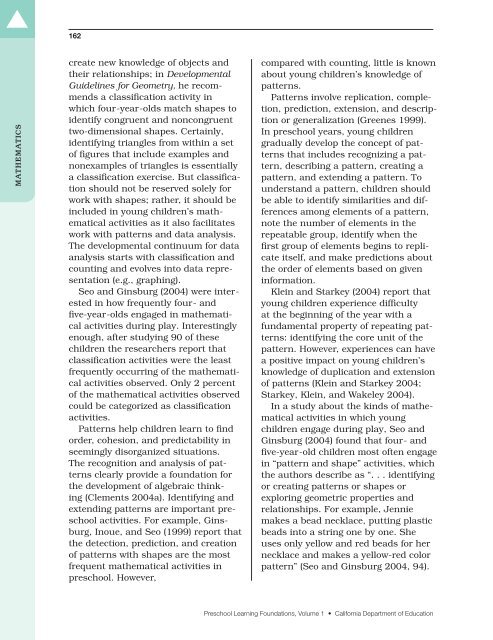California Preschool Learning Foundations - ECEZero2Three ...
California Preschool Learning Foundations - ECEZero2Three ...
California Preschool Learning Foundations - ECEZero2Three ...
You also want an ePaper? Increase the reach of your titles
YUMPU automatically turns print PDFs into web optimized ePapers that Google loves.
MATHEMATICS<br />
162<br />
create new knowledge of objects and<br />
their relationships; in Developmental<br />
Guidelines for Geometry, he recommends<br />
a classification activity in<br />
which four-year-olds match shapes to<br />
identify congruent and noncongruent<br />
two-dimensional shapes. Certainly,<br />
identifying triangles from within a set<br />
of figures that include examples and<br />
nonexamples of triangles is essentially<br />
a classification exercise. But classification<br />
should not be reserved solely for<br />
work with shapes; rather, it should be<br />
included in young children’s mathematical<br />
activities as it also facilitates<br />
work with patterns and data analysis.<br />
The developmental continuum for data<br />
analysis starts with classification and<br />
counting and evolves into data representation<br />
(e.g., graphing).<br />
Seo and Ginsburg (2004) were interested<br />
in how frequently four- and<br />
five-year-olds engaged in mathematical<br />
activities during play. Interestingly<br />
enough, after studying 90 of these<br />
children the researchers report that<br />
classification activities were the least<br />
frequently occurring of the mathematical<br />
activities observed. Only 2 percent<br />
of the mathematical activities observed<br />
could be categorized as classification<br />
activities.<br />
Patterns help children learn to find<br />
order, cohesion, and predictability in<br />
seemingly disorganized situations.<br />
The recognition and analysis of patterns<br />
clearly provide a foundation for<br />
the development of algebraic thinking<br />
(Clements 2004a). Identifying and<br />
extending patterns are important preschool<br />
activities. For example, Ginsburg,<br />
Inoue, and Seo (1999) report that<br />
the detection, prediction, and creation<br />
of patterns with shapes are the most<br />
frequent mathematical activities in<br />
preschool. However,<br />
compared with counting, little is known<br />
about young children’s knowledge of<br />
patterns.<br />
Patterns involve replication, completion,<br />
prediction, extension, and description<br />
or generalization (Greenes 1999).<br />
In preschool years, young children<br />
gradually develop the concept of patterns<br />
that includes recognizing a pattern,<br />
describing a pattern, creating a<br />
pattern, and extending a pattern. To<br />
understand a pattern, children should<br />
be able to identify similarities and differences<br />
among elements of a pattern,<br />
note the number of elements in the<br />
repeatable group, identify when the<br />
first group of elements begins to replicate<br />
itself, and make predictions about<br />
the order of elements based on given<br />
information.<br />
Klein and Starkey (2004) report that<br />
young children experience difficulty<br />
at the beginning of the year with a<br />
fundamental property of repeating patterns:<br />
identifying the core unit of the<br />
pattern. However, experiences can have<br />
a positive impact on young children’s<br />
knowledge of duplication and extension<br />
of patterns (Klein and Starkey 2004;<br />
Starkey, Klein, and Wakeley 2004).<br />
In a study about the kinds of mathematical<br />
activities in which young<br />
children engage during play, Seo and<br />
Ginsburg (2004) found that four- and<br />
five-year-old children most often engage<br />
in “pattern and shape” activities, which<br />
the authors describe as “. . . identifying<br />
or creating patterns or shapes or<br />
exploring geometric properties and<br />
relationships. For example, Jennie<br />
makes a bead necklace, putting plastic<br />
beads into a string one by one. She<br />
uses only yellow and red beads for her<br />
necklace and makes a yellow-red color<br />
pattern” (Seo and Ginsburg 2004, 94).<br />
<strong>Preschool</strong> <strong>Learning</strong> <strong>Foundations</strong>, Volume 1 • <strong>California</strong> Department of Education
















